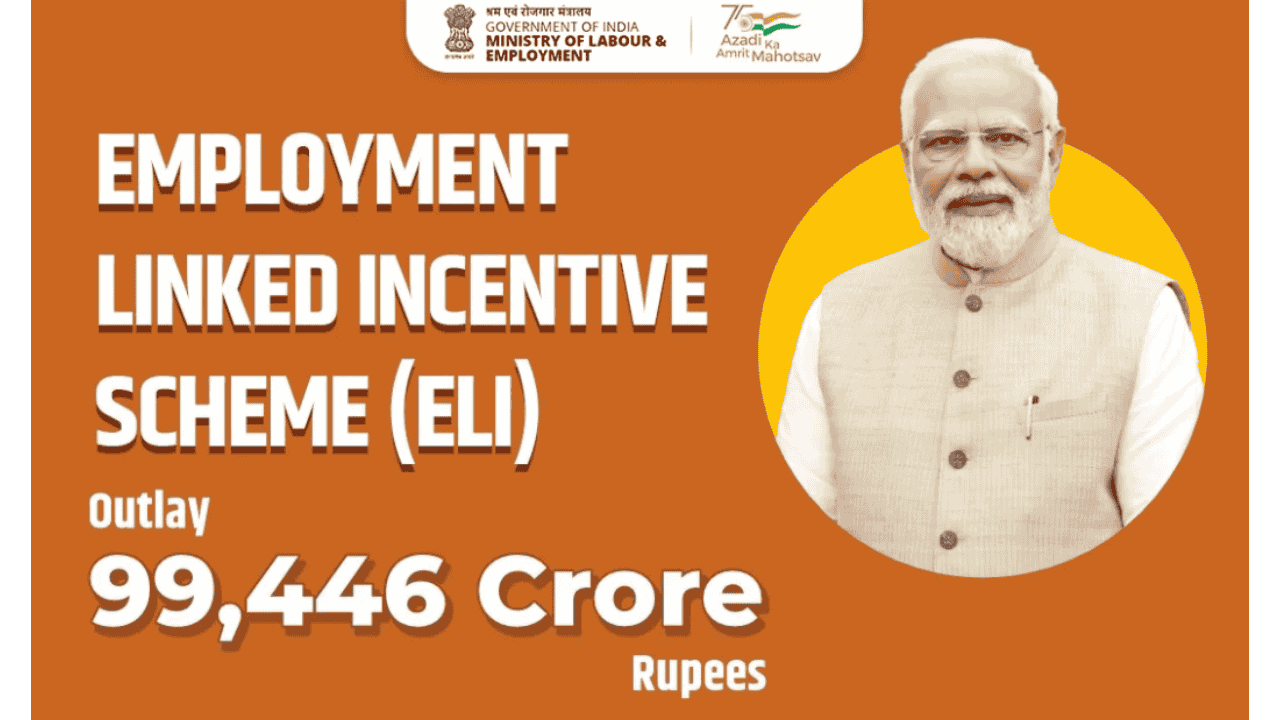Introduction: A Major Shift in India’s Employment Landscape
The Employment-Linked Incentive (ELI) Scheme is one of the most ambitious employment generation initiatives in India’s recent history. Approved by the Union Cabinet on 1 July 2025, this ₹99,446 crore scheme aims to create over 3.5 crore jobs in two years, making it an extremely important topic for UPSC and competitive exam aspirants.
For serious candidates, understanding the ELI scheme is essential as it covers governance, policy implementation, and economic development—core areas of the UPSC syllabus.
What is the Employment-Linked Incentive (ELI) Scheme?
The ELI scheme is a comprehensive employment generation initiative aimed at promoting job creation, enhancing skills, and expanding social security, with special focus on the manufacturing sector.
Background and Context
This scheme was first announced in the Union Budget 2024-25 as part of a package of five schemes targeting 4.1 crore youth with a total budget of ₹2 lakh crore. This initiative reflects the government’s resolve to tackle the growing challenge of unemployment among India’s youth.
Timeline and Implementation
The scheme’s benefits apply to jobs created between 1 August 2025 and 31 July 2027, focusing on maximum job creation within a two-year period.
Scheme Structure and Key Components
The ELI scheme operates through two primary components, addressing both the demand and supply sides of job creation:
Part A: Incentives for First-Time Employees
This component provides direct support to individuals entering the formal sector for the first time:
Eligibility Criteria:
First-time employees registered with EPFO (Employees’ Provident Fund Organisation)
Monthly salary up to ₹1 lakh
Completion of a financial literacy program is mandatory for the second installment
Financial Benefits:
One month’s EPF wage (up to ₹15,000) in two installments
First installment: After 6 months of continuous service
Second installment: After 12 months of service and completion of the financial literacy program
A portion is deposited in a fixed savings account to encourage saving habits
Target Beneficiaries: 1.92 crore first-time employees
Part B: Incentives for Employers
This component incentivizes employers to create additional jobs:
Employer Benefit Structure:
₹1,000 per month for employees with salaries up to ₹10,000
₹2,000 per month for employees with salaries ₹10,001–₹20,000
₹3,000 per month for employees with salaries ₹20,001–₹1,00,000
Duration of Benefits:
2 years for all sectors
Additional 2 years (total 4 years) for the manufacturing sector
Minimum Hiring Requirements:
Firms with fewer than 50 employees: at least 2 additional employees
Firms with 50 or more employees: at least 5 additional employees
Minimum 6 months of service required
Implementation Mechanism and Digital Infrastructure
Payment System
A digital system has been adopted to ensure transparency and prevent misuse:
For Employees (Part A):
Direct Benefit Transfer (DBT) via Aadhaar Bridge Payment System (ABPS)
For Employers (Part B):
Direct payment to PAN-linked accounts
Real-time monitoring and verification
Learning from Previous Schemes
Considering the corruption and fake claims reported in the Aatmanirbhar Bharat Rozgar Yojana (ABRY), ELI has adopted an advanced digital mechanism.
Sectoral Impact and Focus Areas
Priority to Manufacturing Sector
Extended 4-year benefit for manufacturing
Higher incentive structure
Coordination with existing PLI (Production Linked Incentive) schemes
Applicable Across All Sectors
The scheme is applicable across all sectors, enabling widespread job creation.
Strategic Importance for UPSC Preparation
Economic Policy Dimension
This scheme is a supply-side intervention in the labor market, addressing unemployment through:
Lowering hiring costs for employers
Providing income support to new employees
Encouraging formal sector employment
Governance and Implementation
Digital-first approach (Aadhaar-based verification)
Direct Benefit Transfer mechanism
Coordination among EPFO, employers, and employees
Expansion of Social Security
With mandatory EPFO registration:
Formalization of the workforce
Expansion of social security coverage
Financial inclusion (financial literacy)
Critical Analysis and Challenges
Potential Concerns
Distribution Inequality:
Greater benefits likely for large companies
Concentration in industrially developed areas
Implementation Challenges:
Demand-side limitations
Skills mismatch
Trade Union Perspective
Major trade unions like CITU have criticized the scheme, calling it a "deceptive way to transfer public funds to employers."
Comparison with Global Schemes
Global Examples:
USA: Job Retention Credit, Payroll Protection Program
Germany: Kurzarbeit wage subsidy
UK: Furlough Scheme
Indian Context:
Aadhaar-based verification
EPFO integration
Focus on manufacturing
Expected Outcomes and Success Metrics
Quantitative Targets
3.5 crore jobs in two years
1.92 crore first-time employees
₹99,446 crore investment
Qualitative Improvements
Increase in formal sector employment
Expansion of social security coverage
Skill development
Frequently Asked Questions (FAQs)
Q1: What is the total budget for the ELI scheme?
Answer: ₹99,446 crore for two years (2025–2027).
Q2: How will first-time employees benefit?
Answer: Employees registered with EPFO for the first time, earning up to ₹1 lakh, will receive up to ₹15,000 in two installments.
Q3: What are the benefits for employers?
Answer: ₹1,000–₹3,000 per month for each additional employee, for 2 years (4 years for manufacturing).
Q4: What is the scheme’s timeline?
Answer: Applicable to jobs created between 1 August 2025 and 31 July 2027.
Q5: How is this scheme different from previous ones?
Answer: ELI uses advanced digital verification (Aadhaar-EPFO integration) and focuses specifically on first-time employees and the manufacturing sector.
Q6: What is mandatory for employees?
Answer: Activating UAN, linking Aadhaar with bank account, and completing the financial literacy program.
Exam Preparation Strategy
Static vs. Current Affairs
Static:
Employment policy frameworks
Social security systems
EPFO structure
Current Affairs:
Recent policy announcements
Implementation challenges
Stakeholder responses
Related Topics
Labor reforms and new labor codes
Manufacturing sector development
Digital governance initiatives
Social security expansion
Key Takeaways for UPSC Aspirants
The Employment-Linked Incentive (ELI) scheme is a fundamental shift in India’s approach to job creation, moving from traditional guarantee programs to a market-based incentive structure. For UPSC aspirants, this scheme is important from multiple perspectives:
Policy Innovation: Demonstrates targeted intervention through digital technology
Implementation Complexity: Dual structure addressing both demand and supply sides
Stakeholder Role: Responses from various parties highlight the complexity of policy implementation
Economic Integration: Links to PLI schemes and labor reforms
Why this blog matters for your exam strategy:
A deep understanding of the ELI scheme will give you an edge not only in policy questions but also in analytical and current affairs topics. It is a must-know topic for UPSC and State PCS exams.







